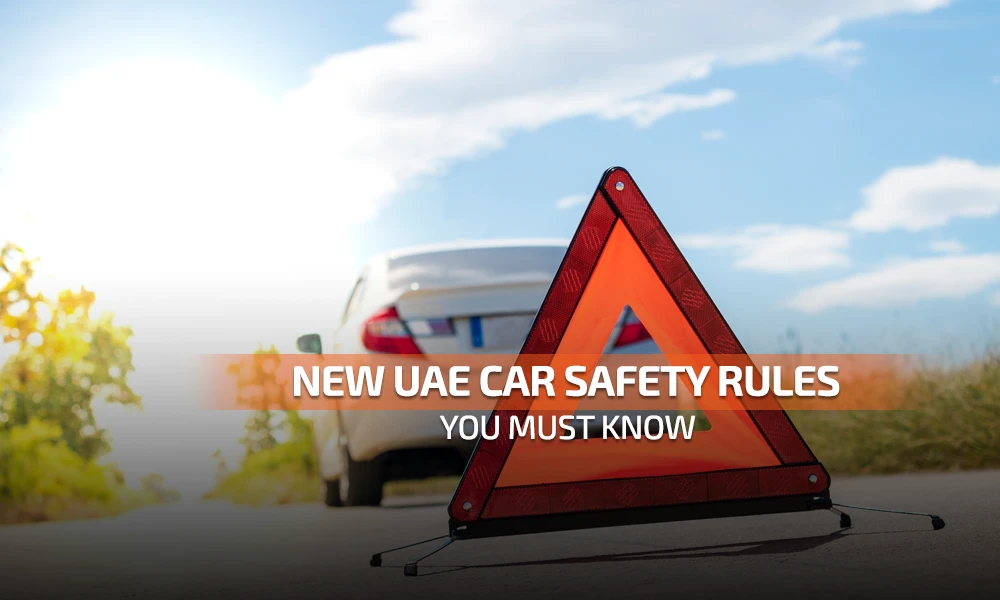Introduction: Why Car Safety is Taking Center Stage in the UAE
In recent years, road safety has become a national priority in the United Arab Emirates. With the government making continual efforts to reduce accidents, save lives, and instill responsible driving, understanding the uae traffic law and uae traffic rules is more crucial than ever.
From emergency lane regulations to advanced in-vehicle safety features, the UAE is paving the way for a safer future on the roads. Whether you’re a long-time resident or a new driver, this blog will walk you through the latest car safety updates every UAE motorist must know.
Emergency Lane Violations Now Come With Heavier Fines
One of the most significant updates in UAE traffic law is the crackdown on emergency lane misuse. According to Miss Auto, failure to give way to emergency vehicles, or driving on emergency lanes without justification, will result in:
- AED 3,000 fine
- 6 black points
- 30-day vehicle impoundment
Why It Matters:
These lanes are reserved for ambulances, police, and firefighting units. Blocking them can cost lives. The authorities have emphasized this rule to ensure swift response during emergencies.
Smart Surveillance to Enforce Lane Discipline and Speed Control
As per the Times of India article, the UAE is employing AI-powered surveillance to automatically detect lane swerving, tailgating, and excessive speeding.
New Smart Traffic Enforcement Includes:
- Cameras that detect phone usage while driving
- AI systems that record distracted driving
- Radar-enhanced speed monitoring
Such systems ensure that violators of UAE traffic rules are penalized swiftly, thereby promoting safer road behavior.
Also Read: UAE’s New Traffic Rules: What drivers ought to know
Mandatory Safety Features in New Vehicles – A Shift Toward Intelligent Cars
According to Arab Wheels, the UAE government has implemented new regulations mandating advanced safety technologies in all new cars sold in the market. These features include:
- Automatic Emergency Braking (AEB)
- Blind Spot Monitoring (BSM)
- Lane Keep Assist (LKA)
- Driver Drowsiness Detection
- Adaptive Cruise Control
These systems work proactively to prevent accidents before they happen and reflect how UAE traffic law is adapting to global best practices.
Also Read: A Detailed Guide to Latest Car Safety Features in the UAE
Child Safety Seats Now Compulsory for All Children Under 4
The UAE traffic rules clearly state that children under the age of four must be secured in a government-approved car seat. Non-compliance can result in:
- AED 400 fine
- Four black points
Authorities urge parents to invest in high-quality, crash-tested car seats that meet UAE standards for safety. This rule helps protect the most vulnerable passengers in your vehicle.
Penalties for Reckless Driving Have Increased
To curb dangerous behaviors, the UAE has stiffened penalties under its updated uae traffic law, including:
- Drifting or performing stunts: AED 2,000 + 23 black points + 60-day vehicle confiscation
- Running a red light: AED 1,000 + 12 black points + 30-day vehicle impoundment
- Not maintaining a safe distance: AED 400 + 4 black points
The aim is clear — make reckless driving costly enough to deter repeat offenses.
Top 10 Recommended Safety Features in Modern UAE Cars
As emphasized in Miss Auto’s guide, modern drivers should look for cars equipped with:
- Airbags (front, side, curtain)
- Electronic Stability Control (ESC)
- Anti-lock Braking System (ABS)
- Traction Control System (TCS)
- Rear-View Cameras
- Tire Pressure Monitoring System (TPMS)
- Adaptive Headlights
- Automatic Braking Systems
- Pedestrian Detection Sensors
- 360-Degree Cameras
These features are rapidly becoming standard under evolving UAE traffic rules, especially for new vehicles in the luxury and premium segment.
Seatbelt Laws for All Occupants – No Exceptions
While front-seat seatbelt rules have always been enforced, the UAE now requires every passenger in the car to wear a seatbelt — regardless of their seating position. Failure to do so can lead to:
- AED 400 fine per unbelted passenger
This rule highlights a growing culture of accountability under UAE traffic law, where every life is considered equally valuable.
The Future of UAE Road Safety: What to Expect
The UAE government is working on several futuristic initiatives to enhance road safety further:
- Mandatory driver fatigue detection systems for long-distance travel
- In-vehicle alert systems integrated with police databases
- Insurance premium discounts for safety compliance
These evolving measures showcase the UAE’s commitment to becoming a global leader in smart mobility and safety-first infrastructure.
What Every Driver Can Do to Stay Compliant
To stay aligned with uae traffic law and avoid penalties:
- Regularly review traffic rule updates on official channels
- Enroll in safe driving workshops
- Install a dashcam for added accountability
- Avoid mobile phone usage unless hands-free
- Never tailgate or overtake dangerously
Staying informed isn’t just about avoiding fines — it’s about safeguarding your life and others on the road.
FAQs
Driving on emergency lanes without reason can lead to AED 3,000 fine, 6 black points, and 30-day vehicle impoundment.
Yes, seatbelts are now compulsory for all occupants under the latest uae traffic law.
Smart cameras detect violations; fines can reach AED 800 with 4 black points.
Yes, children under 4 must be in a certified car seat or face a fine of AED 400.
Features like AEB, lane assist, blind spot monitoring, and driver fatigue detection are becoming standard.
Conclusion: Driving Toward a Safer Tomorrow in the UAE
The UAE is on a mission to make its roads some of the safest in the world. The evolution of UAE traffic rules reflects a proactive, technologically advanced, and safety-centric approach to road governance. As drivers, our role is simple — follow the law, drive responsibly, and always prioritize safety.
If you’re in the UAE, staying updated on UAE traffic law is not optional—it’s essential. From smart cars to smart surveillance, the country is building a future where safety isn’t just a guideline—it’s a guarantee.







